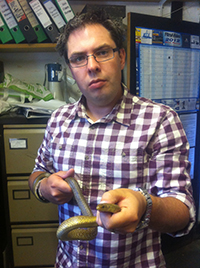Profile of Dr Stuart Graham

- Name
- Dr Stuart Graham
- Position
- Honorary Research Fellow
- bspc12@bangor.ac.uk
- Phone
- Location
Profile
Research Interests
I have two main areas of research on disparate groups of organisms in different geographical regions (Reptiles in the UK and India and Amphibians in UK and Europe). My research interests lie in habitat utilisation and conservation biology, focusing on spatial and temporal utilisation of habitats to identify mechanisms for the conservation of small, fragmented populations of European Protected Species (EPS) and / or Ecologically Distinct Units (EDU).
Another strand of my research involves venomous snakes and snakebite mitigation, and I am currently involved in several projects in India, dubbed the "snakebite capital of the world", where c. 50,000 people die from snakebite every year and many more suffer permanent disability. Supporting Dr Anita Malhotra and partners in India, our work ranges from mapping the distribution, genetic and venom variation present in venomous species across the country, to undertaking rescuer training and education & awareness programs. We are particularly focussing on the Himalayan and north-eastern region, which belong to biodiversity "hotspots" but are relatively understudied. The venomous species in these regions are different to the rest of the country, not covered by the currently available polyvalent antivenom.
Qualifications
- PhD: The Conservation of UK Dune System Native Lacertidae Species
Bangor University. 2010 – 2018
- MSc: Environmental science
University of Wolverhampton, 2003 – 2004
- BSc (Hons): Environmental science
University of Wolverhampton, 2000 – 2003
- Chartered Ecologist
Chartered Institute of Ecology and Environmental Management (2014 - ) - Chartered Environmentalist.
Chartered Institute of Ecology and Environmental Management (2012 - )
Research
Publications
2019
- Confirmation of Naja oxiana in Himachal Pradesh, India
Vishal Santra, John Benjamin Owens, Stuart Graham, Wolfgang Wüster, Sourish Kuttalam, Omesh Bharti, Melvin Selvan, Nilanjan Mukherjee, Anita Malhotra, 02 August 2019, (Accepted/In press) In : Herpetological Bulletin
Research output: Contribution to journal › Article
2018
- Prevention is better than cure: snakebite education in India
Togridou, A., Graham, S., Santra, V., Owens, J. B., Bharti, O. & Malhotra, A., 27 Nov 2018, (Accepted/In press) In : Episthmes Agogis .
Research output: Contribution to journal › Article
2014
- Graham, S. A. (2014). Natrix natrix (Grass snake): Habitat. Herpetological Bulletin, British Herpetological Society. (Published)
Research output: Contribution to journal › Article
Activities
2019
- ARC-ARG UK Herpetofauna Workers’ Meeting, Stoke-on-Trent, England (09-10/01/2019).
INNS and outs of the Welsh amphibian fauna (with Dr. Liz Howe. NRW).
Activity: Types of External academic engagement - Invited talk (Speaker)
2018
- University of Chester, CWT & BES, Future directions for the management of small populations, University of Chester, England (10/04/2018). Chasing the dragon: an evaluation of the Lacerta agilis reintroduction sites in North Wales.
Activity: Types of External academic engagement - Invited talk (Speaker)
2017
- ARC-BHS Joint Scientific Meeting, Bournemouth, England (02/12/2017).
Chasing the dragon: an evaluation of the Lacerta agilis reintroduction sites in North Wales.
Activity: Types of External academic engagement - Invited talk (Speaker)
2012
- Wales Amphibian and Reptile Symposium 2012, Llandrindod Wells, Wales (03/11/2012). Improving detection of the ‘Welsh Common Lizard’ (Zootoca vivipara).
Activity: Types of External academic engagement - Invited talk (Speaker)
- Herpetological Bulletin – British Herpetological Society
Associate Editor
2012
Links: https://www.thebhs.org/publications/the-herpetological-bulletin
Projects
Biodiversity Informatics and Technology Exchange for Snakebite Management
13/12/2013 – Ongoing
Description
India has the globally highest annual death rate from venomous snake bites and in some states it is the largest contributor to mortality, exceeding even AIDS and malaria. Data on snakebite is significantly lacking from the north-eastern and Himalayan belt States, where the “Big Four” medically significant venomous snakes are replaced by different sets of venomous snakes. This has serious consequences for the ability to treat cases of snakebite.
Clinical management of snakebites requires timely administration of antivenom (referred to in India as anti-snake-venom serum, or ASVS), neutralizing the life-threatening toxins in snake venom. However, venom composition varies both between and within species, and so the design and production of efficient antivenins depends on thorough understanding of venomous snake diversity and distribution. The resulting biological information and standards from this project will contribute to improving the outcome of snakebite and provide a baseline for future work.
This project is funded by the European Union Seventh Framework Programme under the grant agreement number PIRSES-GA-2013-612131, with additional funding from the Bangor University ESRC Impact Acceleration Account.
Links: http://bites.bangor.ac.uk
European Union Seventh Framework Programme under the grant agreement number PIRSES-GA-2013-612131
13/12/2013 – 12/12/2017 (Finished)
Knowledge Exchange Student
ESCR-IAA grant: Prevention is better than Cure: Snakebite mitigation in India
01/04/2019 – 31/07/2019 (Finished)
Co-Investigator
